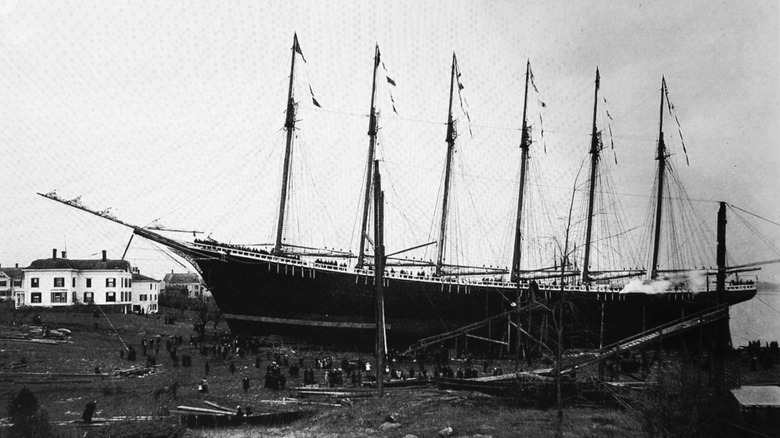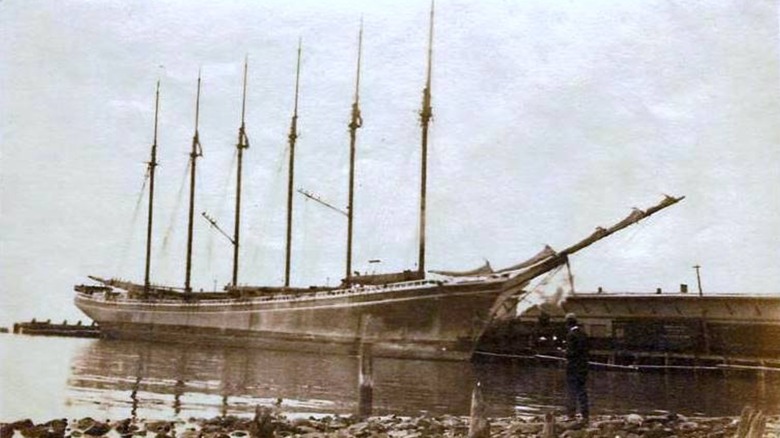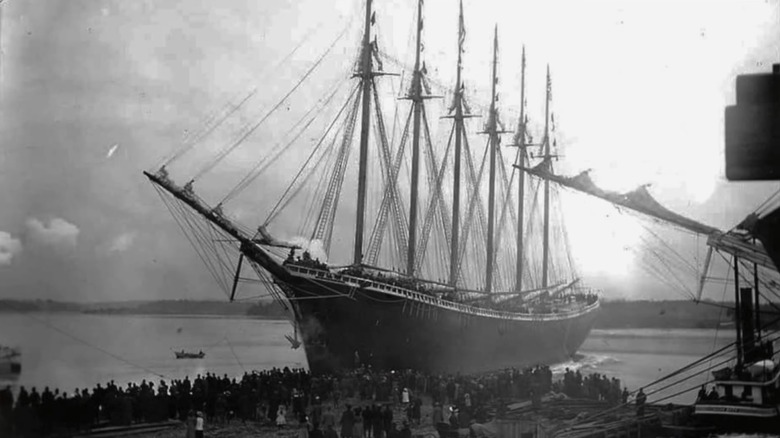Why The World's Largest Wooden Ship, The Wyoming, Was A Bad Idea From The Start
For almost the entirety of human civilization, large structures like buildings and ships have been constructed primarily out of wood. This makes sense, seeing as it's a relatively common material that's sturdy and somewhat easy to source. These days, we continue to frame houses with wood; it's not typically used to build modern ships unless you're talking about a specialty ship or some of the most expensive celebrity yachts floating on the water.
The infamous Spruce Goose flying boat was made of wood, but outside of a handful of examples, most aircraft and boats are made of steel and a variety of composite materials. Some wooden ships, like the USS Constitution, have an incredible history, but that's also true of the largest ever constructed, the SS Wyoming. The Wyoming was a schooner built in 1909, and it gained a bit of fame for being the largest wooden ship ever built. Believe it or not, there's an upper size limit for wooden vessels, and the Wyoming exceeded it.
The vessel was built in Maine for the purpose of transporting coal, and it boasted six 126-foot masts and 22 sails, so it was a considerably large ship. While modern vessels and those built out of steel at the time were larger, the fact that the Wyoming was constructed with wood was problematic. The larger the ship, the more stress it endured on the water, and the Wyoming suffered greatly throughout its relatively short time sailing the seas despite earning enough to justify its expense. Here's the story of the fateful ship, the SS Wyoming.
The SS Wyoming
The SS Wyoming was a massive vessel, measuring 450 feet in length with a 350-foot-long deck. It used 1.5 million feet of Southern pine and 12,000 square yards of canvas in its construction. Its beam measured just over 50 feet, and it displaced 10,031 tons. For comparison, the wooden warships constructed by the U.S. for World War I didn't exceed 340 feet in length, so the Wyoming was unusually massive. Its cargo hold could carry around 6,000 tons of coal, and in 1910, the average cost of coal was around $12 per ton.
Given its capacity, the Wyoming could initially carry somewhere around $72,000 worth of coal, which would be over $2 million adjusted for inflation. That certainly made the size of the Wyoming worth the cost of its construction and maintenance, which was significant. The vessel first set sail in 1909, and it continued operating for 15 years. In 1916, it was chartered by the International Paper Company, and in 1917, it was sold to France & Canada Steamship Co.
The Wyoming continued sailing through World War I, evading a German U-boat during one voyage, and it continued operating until 1924 when tragedy struck. On March 11, 1924, the Wyoming attempted to ride out a nor'easter storm by anchoring off the coast of Massachusetts in the Nantucket Sound. At some point during the storm, the ship was floundered and sank, taking all 13 crew with it. The wreck of the Wyoming remained undiscovered until it was finally located in around 70 feet of water by American Underwater Search and Survey Ltd. in 2003.
Why the Wyoming was too large for its own good
Wood can only grow so long, and joining beams for ship construction limits their size, but the shipbuilders responsible for the Wyoming's construction continued pushing that envelope. The longer the ship, the more stress it endures when crossing the crests and troughs of oceanic waves, which causes sagging in heavy seas. The wood buckles and bends when this happens, allowing water to enter the hold, which must be pumped out. This happened constantly with the Wyoming, so large metal cross-braces were strapped onto the vessel to hold the ship together.
Ultimately, it was the vessel's size that doomed it when it faced a devastating nine-day storm. With 5,000 lbs. of coal in its hold, the Wyoming likely sagged and hogged so much in the storm she ultimately buckled, snapping in the middle, either while afloat or once it swamped and hit the bottom. To the shipbuilders' credit, the Wyoming was never intended to be the largest wooden ship ever constructed. At the time, it wasn't known what the upper size limit of wooden sailing ships allowed. They just wanted the ship to carry as much coal as possible and constructed her for that purpose.
Unfortunately, the reality of the ocean's waves, the bendable nature of wood, and the upper size limit of its construction doomed the Wyoming to its watery fate, where it remains as a gravesite due to the lives lost when it sank. By the time she sank, wooden sailing ships were made obsolete by more robust steel vessels, making the Wyoming something of a curiosity, as it's the last ship of its kind. Despite sinking, there's no denying it was a financially successful schooner, but the Wyoming stands as a stark reminder that there are natural limits to the things we construct.


